Mariani's Virtual Gourmet Newsletter
June 19, 2011
HOME
| CURRENT ISSUE
| ARCHIVES
| QUICK BYTES
| SUBSCRIBE
| ABOUT
US | BOOKS
| CONTACT
|
ADVERTISE
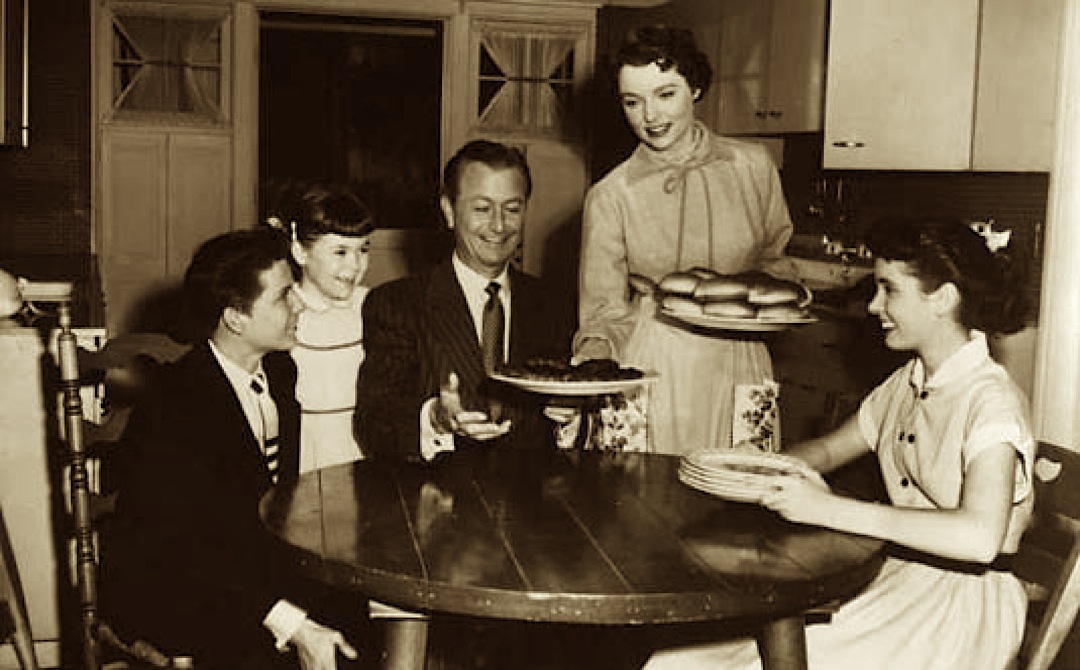
Billy Gray,
Lauren Chapin, Robert Young, Jane Wyatt and Elinor Donahue in the TV
series "Father Knows Best" (1954-1960)
THIS WEEK
TURIN: HIDING IN PLAIN SIGHT, PART ONE
by John Mariani
NEW YORK CORNER: JONES WOOD FOUNDRY
by John Mariani
MAN ABOUT TOWN: GAZALA PLACE
by Christopher Mariani
WINE: AMERICAN SAUVIGNON BLANCS' STYLES TOUGH TO PIN DOWN
by John Mariani
GOOD NEWS! Esquire.com now has a new food section called "Eat Like a Man," which will be featuring
restaurant articles by John Mariani and others from around the USA.
THIS WEEK: The Best Desserts of 2011 (So Far).
Mariani's Quick Bytes
If you would like to be featured in our Quick Bytes section please visit our advertisement page at www.JohnMarianiMedia.com
Quick Bytes is your way of staying in touch with what's new and what's happening in the restaurant world. Quick Bytes
features restaurant openings, prix fixe menus, chef announcements, hotel deals, special events and much more.
*Paid Advertisements*
|
Marcello's Ristorante 25th Anniversary Wine
Tasting and Concert
Marcello's
Ristorante
of
Suffern, NY
celebrates his 25th anniversary with the release of his new cookbook
with two live concerts at the historical Lafayette Theater. On 6/16 artists Cristina
Fontanelli,Gary Wilner,Big Band, on 6/23
Giada Valente,Antonio Ciacca, Albin Konopka, Elsebeth Dreisig, Ivan
Dimitrov and Ornella Fado. Please visit www.marcellosgroup.com
for
details and to view the playbill. The pre-theater wine tasting at
Marcello's Ristorante is already sold out but we still have concert
tickets available. If you are not attending the concert, the wine
tasting of 8:00, 9:30 are still available with live music.Cost of wine
tasting and Italian antipasto is $25 all incl. Call 845-357-9108 for
tickets. Grazie!
|
|
Gather Restaurant
On June 22 Gather Restaurant
in Berkeley, CA will host
a Hodo Soy/Magruder Ranch $47.00 four-course prix fixe dinner prepared
by Esquire Magazine’s “Chef of the Year” Sean Baker with continuous
service from 5:00 to 10:00 p.m.; Mac MacGruder and the owner of Hodo
Soy will be at the dinner; vegan alternatives available; optional wine
pairing also offered; 2200 Oxford Street; (510) 809-0400; www.gatherrestaurant.com |
|
Quattro
HOUSTON
…Executive Chef
Maurizio Ferrarese of Quattro at the Four Seasons Houston Hotel is
pleased to announce the kick-off of a Summer Guest Chef Series at the
award-winning restaurant. The series kicks off on Friday, June 24 and Saturday, June 25
with a Two Chef Dinner with Chef/Owner David Denis of Le Mistral.
Chefs Ferrarese and Denis will collaborate on a four-course dinner that
will feature Italian and French influences side-by-side on each
plate.
Cost is $65 per person plus tax and gratuity (Groupons cannot be used
for these dinners). Quattro is located in the Four Seasons Hotel
Houston is located at 1300 Lamar at San Jacinto. For more information,
visit
www.quattrorestauranthouston.com or call 713-276-4700. |
|
Spectrum Wine Auctions
On June 25-26, Spectrum Wine
Auctions will hold its Summer 2011 Auction in Hong Kong. The auction will
feature wines from three major single-owner collections. Bids may
be placed live in the auction room, online and by phone, or in advance
via fax. Interested buyers may preview 360-degree photographs of
bottles from each lot prior to the sale, and may request a
complimentary catalog at www.spectrumwine.com. |
|
Bond 45
NYC's Times
Square fine-dining favorite Bond 45 (154 West 45th Street,
212-869-4545, www.bond45.com)
is
offering
an
unbeatable
$15
Lunch
Special
at the bar from 11:30am to
4pm Monday to Friday. From pleasing pasta dishes to succulent seafood
and steak items, you can enjoy a different and delicious dish each day
from Culinary Director Brando De Oliveira. On Mondays indulge in
classic Spaghetti & Meatballs; on Tuesdays savor Penne with Sausage
Amatriciana; on Wednesdays, a tasty Tagliatelle with Filet Mignon
Braciola; on Thursdays, Gramigna with Pulled Pork Ragu; and on Fridays,
a flavorful Orecchiette with Red Wine Braised Calamari. |
|
Le Caprice
On weekdays from 12pm to 3pm at the modern Le Caprice (795 Fifth Avenue,
212-940-8195,www.lecapriceny.com),
you
can
enjoy
Executive
Chef
Ed
Carew's
"lunch at the bar" menu with
flavorful offerings like a Scotch Egg with celery salt ($8), Scottish
Smoked Salmon with lemon and capers ($14), and an exquisite Welsh
Rarebit ($10). And with Central Park right across the way, Le Caprice
is an ideal spot for a midday meal. |
|
Columbus Tavern
Columbus Tavern's (269 Columbus Avenue, NY 212-873-9400,
www.columbustavern.com)
old-world feel and delectable lunch menu can be enjoyed at their 100
year-old mahogany bar. Executive Chef Phil Conlon offers playful dishes
like BLT Dumplings with spicy mustard and salted radishes ($7.50),
Triple Mac & Cheese with spiral pasta and roasted tomatoes ($11),
and ChefPhilly's Cheese Steak ($13). While there, you can also enjoy
unique cocktails inspired by Upper West Side buildings like The Ansonia
and The Dakota ($12 each). |
|
Benjamin Steakhouse, White Plains, NY
Benjamin Steakhouse: White Plains NY seeks an energetic, self-motivated Events/Marketing professional to promote the restaurant and handle all banquet sales/private events. Ideal candidate must have excellent communication skills, as well as a minimum of 1-2 years of professional experience in events, sales, or within the hospitality industry. Strong sales and administrative skills are key, as well as attention to detail, good organizational skills and the ability to multitask. Self-motivation is crucial! Must be able to promote, book, and coordinate events from start to finish!! Familiarity with the area is a plus! Interested candidates may email a resume, as well as a description as to why you would be a good fit to cynthia@benjaminsteakhouse.com. |
Place you Quick Byte Here |
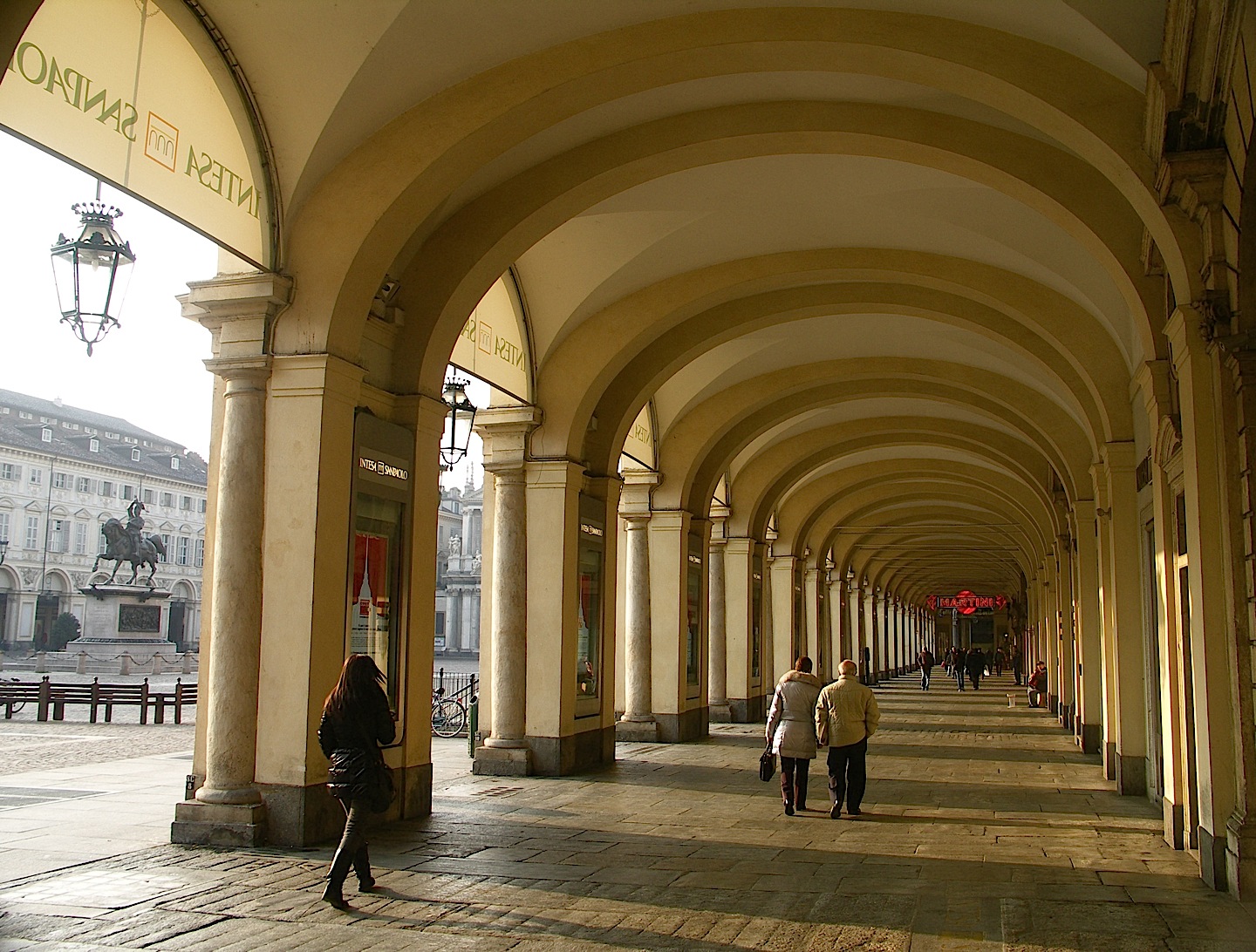
“Not even the Italians know Turin! They only know FIAT! FIAT! FIAT!”
So said Michele, a spry, elegant, elderly Turinese who took my wife and me for a cup of rich bittersweet coffee and chocolate called a “capriccio” at the historic Caffè Baratti e Milano (below), opened in 1875 on Turin’s broad Piazza Castello. We’d met him just minutes before on our search for the equally famous café named Bicerin, only to learn from Michele that it was closed on Wednesdays.
He didn’t seem troubled by his statement that the world outside of Piedmont, including the rest of Italy, did not regard his hometown as worth visiting, unless it was to see the Automobile Museum. “It is not a bad thing not to have so many tourists,” said Michele, who had a salt-and-pepper beard and wore an artfully thrown scarf around his shoulders. He never gave us his last name and who seemed to have retired to the life of a boulevardier known to every bartender and barrista in Turin.
“Look
around
you,”
he
said,
smiling.
“Turin
is
never
noisy,
never
crowded,
except”—his
eyes
rolled
back—“during
those
Winter Olympics! So we Torinesi have our
restaurants
and cafés all to ourselves most of the time.
Our mercato 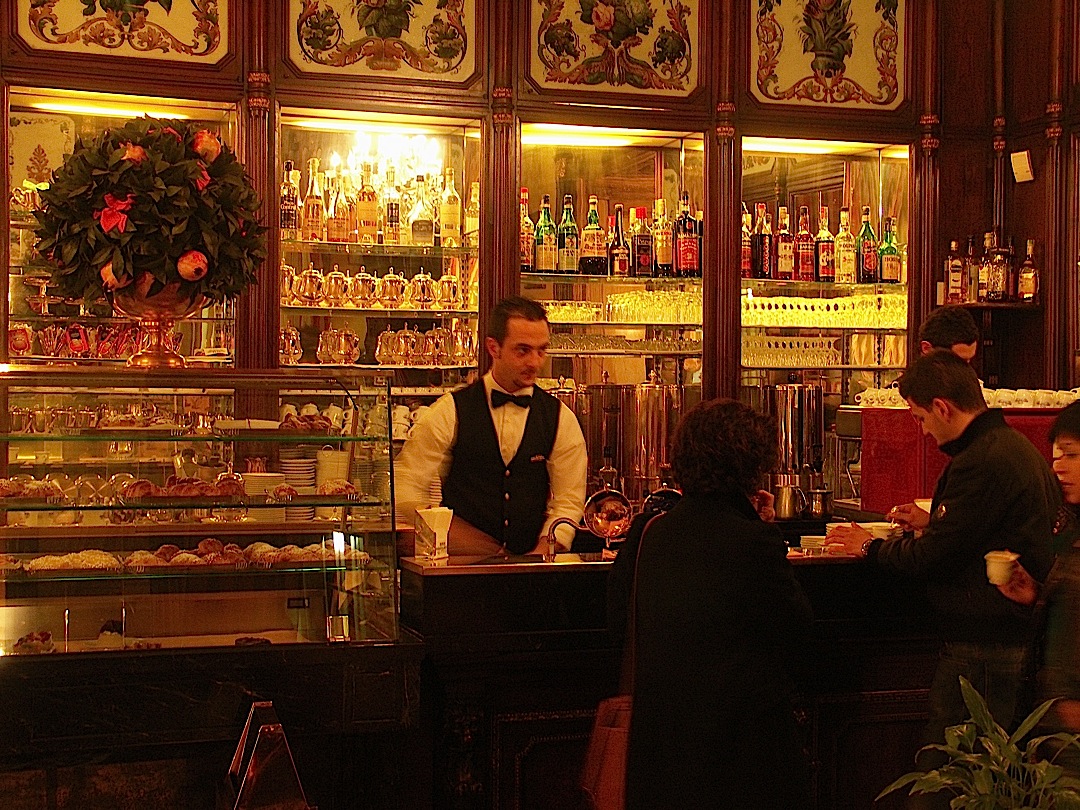 sells
every
kind
of
food
and
wine
you
could
possibly
want,
and
that
new
place EATaly is just a few kilometers that
way.” He
waved his hand in the general direction of the gargantuan food market
and
restaurant complex established in 2007 in the out-of-the-way Lingotto
district.
He shrugged. “Maybe I visit someday.” And then he was off, saying he
was
meeting friends at a trattoria whose name he neglected to share with us.
sells
every
kind
of
food
and
wine
you
could
possibly
want,
and
that
new
place EATaly is just a few kilometers that
way.” He
waved his hand in the general direction of the gargantuan food market
and
restaurant complex established in 2007 in the out-of-the-way Lingotto
district.
He shrugged. “Maybe I visit someday.” And then he was off, saying he
was
meeting friends at a trattoria whose name he neglected to share with us.
I must admit that I, too, had little knowledge or interest in Turin, having only paid brief visits to the city in the past while attending a food conference or simply passing through to tour the beauty of the Piedmontese countryside and wine country, where some of the region’s most noted restaurants, like Combal Zero in Rivoli, Locanda del Pilone in Alba, and Delle Antiche Contrade in Cuneo, are located. My earlier visits had, however, disabused me of any thought that Turin was a drab, self-absorbed northern industrial city. It is worth noting that director Michelangelo Antonioni used Milan in “La Notte” (1961), Rome in “L’Eclisse” (1962), and Ravenna in “Il Deserto Rosso” (1964)—not Turin—to depict the deadening effect of industrialization on the soul of modern Italy.
On
a
recent
extended
visit,
I
found
the
heart
of
the
city
among
the
most
beautiful
in
Europe, justly famous for its long, graceful series of arcades, the
grandeur of
its vast piazzas, and its stately and highly efficient grid pattern. The Po River flows as majestically
through Turin as the Arno does through Florence and the Tiber through
Rome.
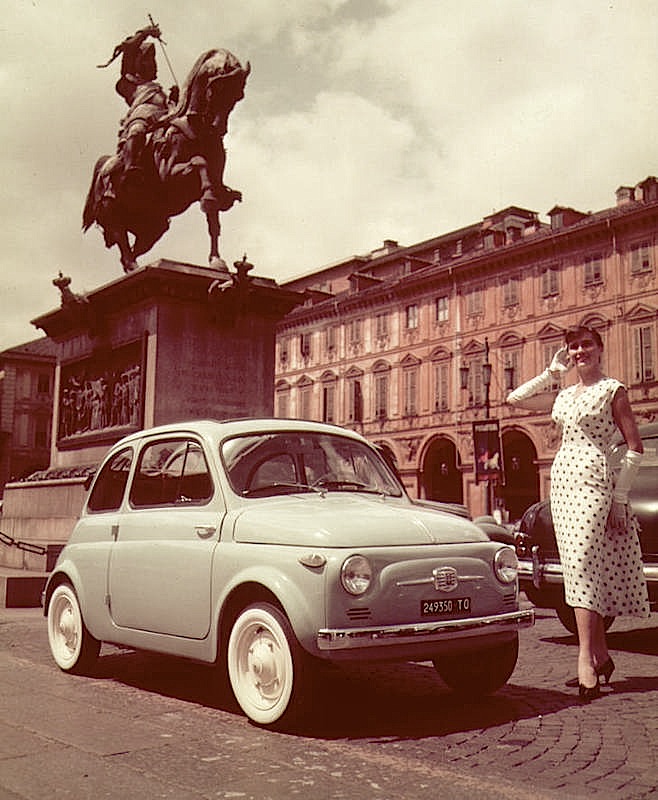 FIAT
has,
of
course,
dominated
and
buoyed
Turin’s
fortunes
since
1899
(it
still
produces
37
percent
of
Italy’s GNP) and had an enormous hand in the post-war
Italian Economic Miracle called Il Boom, when it released the two
cylinder Fiat 500 (Cinquecento) in 1957 (left), which was both very
efficient and affordable for upwardly mobile Italians. Still,
the Torinesi are quick to remind people
that their
city was in fact the first capital of an Italy unified in 1861 under
Victor
Emmanuel II, whose Royal Palace, set in the huge square entered from
the broad
Via Roma, is a spectacular example of a baroque opulence intended to
reflect
the proud independence of Piedmont, which only 50 years earlier had
been
annexed by Napoleon Bonaparte. Upon
invading Italy in 1800, the young Corsican general faced
20,000 Piedmontese and 11,500 Austrians, but his tactical genius
divided his
enemies and, in embarrassment, King Victor Amadeus II ceded Piedmont to
the
Corsican, who immediately demolished Turin’s city gates and bastions
and renamed
the Royal Palace as the Imperial Palace—a decree that horrified and
humiliated
the Torinesi. Napoleon’s defeat at
Waterloo in 1815 freed Piedmont, whose power increased in the decades
leading
up to 1861, when it became the capital of the new Italy.
FIAT
has,
of
course,
dominated
and
buoyed
Turin’s
fortunes
since
1899
(it
still
produces
37
percent
of
Italy’s GNP) and had an enormous hand in the post-war
Italian Economic Miracle called Il Boom, when it released the two
cylinder Fiat 500 (Cinquecento) in 1957 (left), which was both very
efficient and affordable for upwardly mobile Italians. Still,
the Torinesi are quick to remind people
that their
city was in fact the first capital of an Italy unified in 1861 under
Victor
Emmanuel II, whose Royal Palace, set in the huge square entered from
the broad
Via Roma, is a spectacular example of a baroque opulence intended to
reflect
the proud independence of Piedmont, which only 50 years earlier had
been
annexed by Napoleon Bonaparte. Upon
invading Italy in 1800, the young Corsican general faced
20,000 Piedmontese and 11,500 Austrians, but his tactical genius
divided his
enemies and, in embarrassment, King Victor Amadeus II ceded Piedmont to
the
Corsican, who immediately demolished Turin’s city gates and bastions
and renamed
the Royal Palace as the Imperial Palace—a decree that horrified and
humiliated
the Torinesi. Napoleon’s defeat at
Waterloo in 1815 freed Piedmont, whose power increased in the decades
leading
up to 1861, when it became the capital of the new Italy.
As
an
imperial
city,
Turin’s
artistic
treasures
are
exceptionally
fine,
all
in
baroque
wrappings.
Although
there
is no museum the equivalent of Florence’s
Uffizi or
the Brera in Milan, the Royal Palace itself (below)—once residence of the
powerful
Savoy dynasty, taken over by the Italian government in 1946--is
crammed with
notable works. My wife and I were
amazed at room after room of imperial salons, including Queen Maria
Theresa’s
quarters, in every color of marble, each with trompe l’oeuil painted
ceilings,
and we were particularly impressed with the palace’s  collections
of
exquisite
tapestries
and
Chinese
porcelain.
collections
of
exquisite
tapestries
and
Chinese
porcelain.
We toured the city’s Egyptian Museum at the Academy of Science, considered one of the finest of its kind in the world, on top of which sits the admirable Sabauda Gallery, with works by Bronzino, Veronese, Jan Van Eyck, and Van Dyck. And to gain a sense of the unique way that Piedmontese royalty could actually welcome the red-shirted rebels of Garibaldi’s army, the Museum of the Risorgimento in the Palazzo Carignano, where the first parliament of 1861 met, depicts the region’s history from the 19th century through Unification, and on through two world wars.
The splendid Duomo of St. John the Baptist, still home to the now wholly discredited Shroud of Turin, is the city’s only true example of pre-baroque Renaissance architecture. And, as everywhere else in Italy, there seems a church or chapel on every block.
Uniquely
Turin,
however,
is
its
National
Museum of Cinema, set inside a landmark
500-foot tower originally designed as a synagogue in 1863 by Alessandro
Antonelli. We wound from hall to
hall and room to room over five floors, flanked with flickering images
of
early shadow
cartoons and the first primitive, silent efforts of Thomas Edison;
within the play
of chiaroscuro and expressionist lighting that evoked “The Cabinet of
Dr.
Caligari,” there are mini-theaters, and long corridors lined with huge
movie
posters from every era. There is
also a futuristic café-restaurant (left) on the ground floor whose
starkness, color
and light could be a setting for a bar in “Star Wars” or “Bladerunner”
that fits
perfectly into the ambiance of the museum.
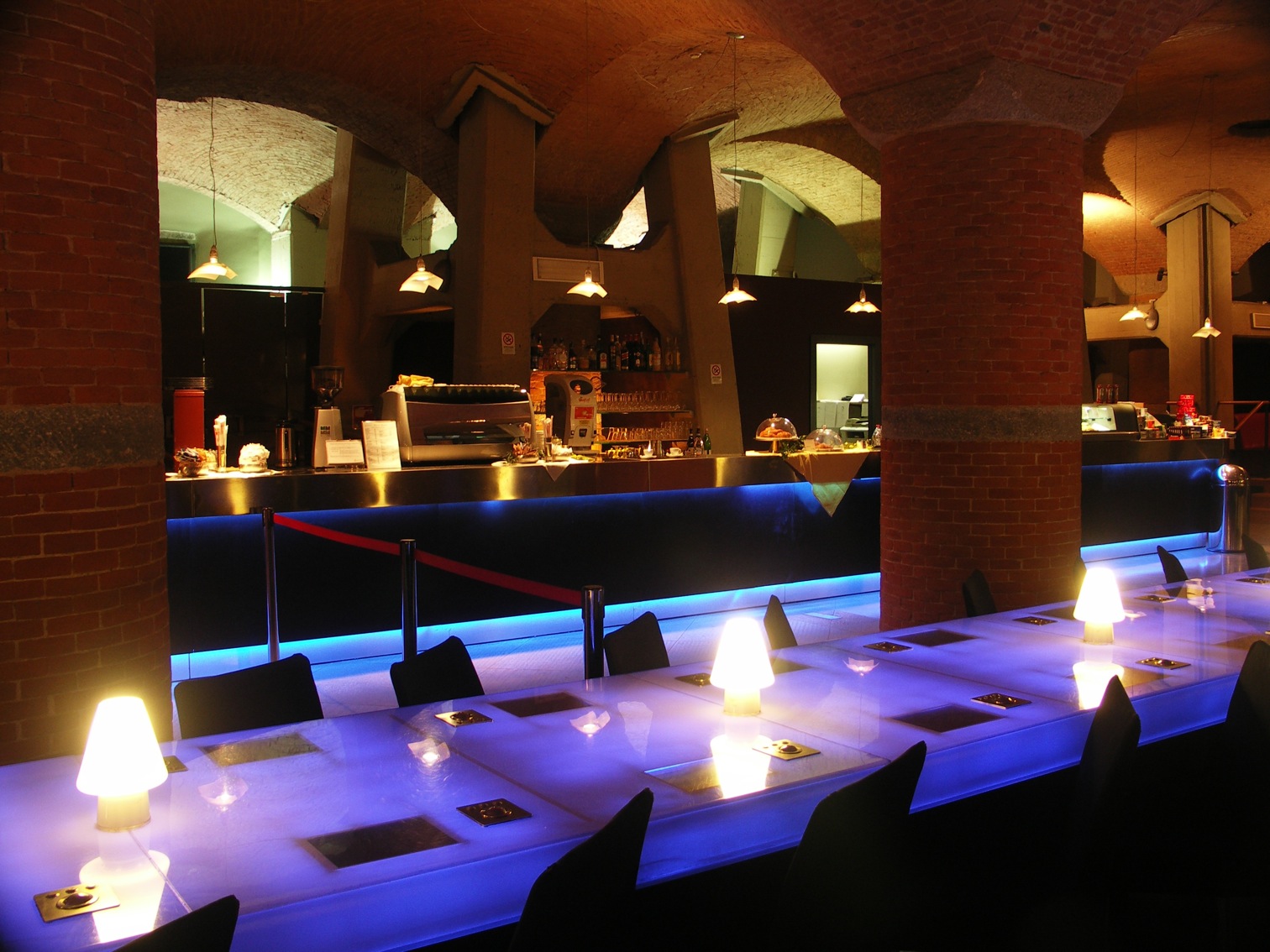 But
if you ask a Torinese where his city’s true artistic achievements lie,
he might
well say they are in those beautiful arched walkways that line miles of
streets
and plazas throughout the city center. Of
even height, woven throughout the city along the city
center so as to connect with one another, the arcades were built over
the
course of two centuries, principally as shelter from Piedmontese
winters but also
as showcases of banks and boutiques, antique pharmacies and food shops,
and,
more than anything else, cafés and candy emporiums.
Look above their doorways and you see stencils and
carvings
from the 18th and 19th
centuries. Their
façades are done in black marble
or richly varnished mahogany, usually in the baroque style but also in
more
“modern” styles of Art Nouveau or Art Déco, and they act very
much like picture
frames for paintings.
But
if you ask a Torinese where his city’s true artistic achievements lie,
he might
well say they are in those beautiful arched walkways that line miles of
streets
and plazas throughout the city center. Of
even height, woven throughout the city along the city
center so as to connect with one another, the arcades were built over
the
course of two centuries, principally as shelter from Piedmontese
winters but also
as showcases of banks and boutiques, antique pharmacies and food shops,
and,
more than anything else, cafés and candy emporiums.
Look above their doorways and you see stencils and
carvings
from the 18th and 19th
centuries. Their
façades are done in black marble
or richly varnished mahogany, usually in the baroque style but also in
more
“modern” styles of Art Nouveau or Art Déco, and they act very
much like picture
frames for paintings.
One
of
the
most
famous
is
The
Baratti
&
Milano
(1875),
which
bears
the
imperial
crest
given
it by the Vittorio II. The King
and Garibaldi toasted the Reunification at Caffé Mulussano,
later relocated in
1907 and done in the sleek art déco style of that period.
Litterateurs
have
long made Caffé
Fiori (1873) their second home, and in his day FIAT founder
Gianni Agnelli passed his few idle hours at Caffé Piatti (1875). And while
each
has its secrets of coffee making, it is likely that the locally
produced
Lavazza coffee is the starting point for the artfulness.
While café culture vitalized every
large city in Italy during the 19th
century, none but Turin brought
it to an art form in and of itself, where the cafés were
extravagant
testimony
to the luxurious pleasures of taking time to sit, drink and talk. Indeed, it is the arcades that allow
for such an extravagance of cafes barely imitated in 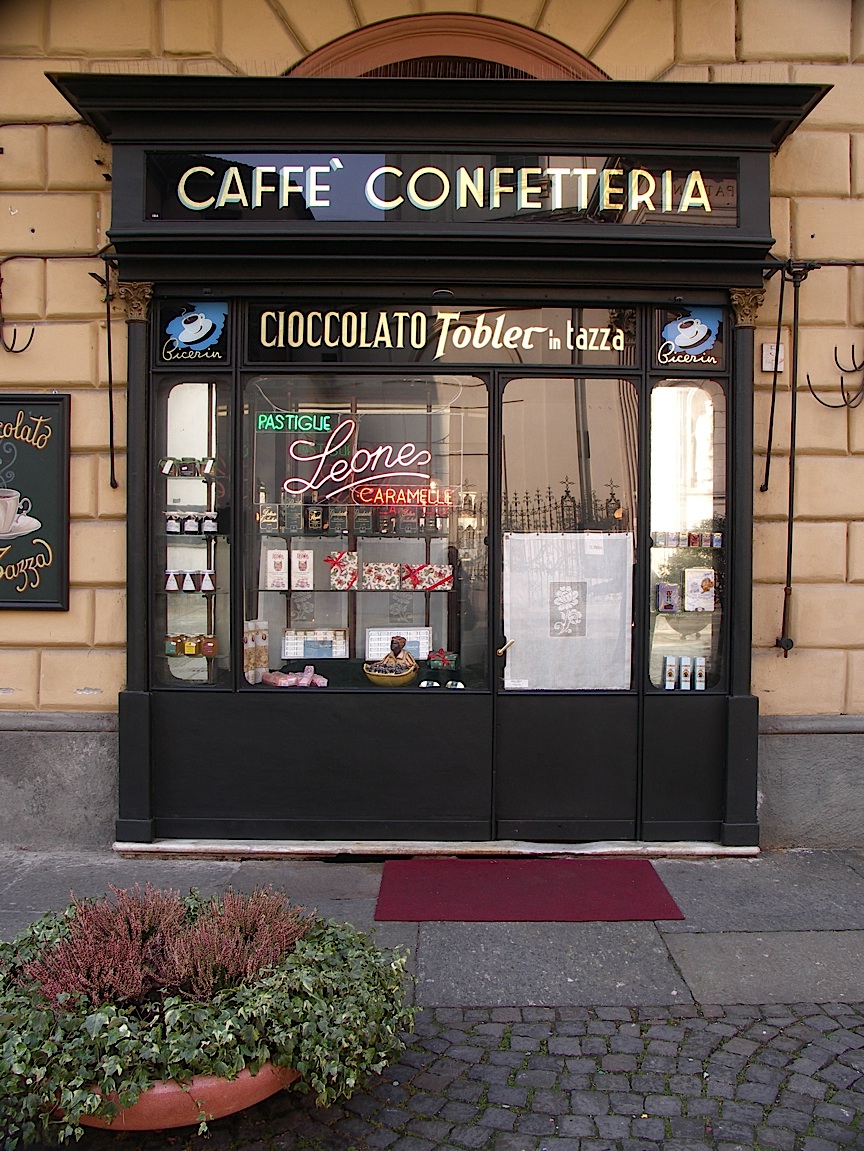 Venice’s
Piazza
San
Marco.
Venice’s
Piazza
San
Marco.
Through the spotless windows we saw countless displays of the most beautifully crafted chocolates, marzipan, and sugared fritters in pastel colors, pink paper, gold foil, arrayed in painted tin boxes or set on lace doilies. The soft lighting inside is never harsh, never low, imparting a Christmas ornament’s appeal to the confections every day of the year.
And then there is the aroma of the chocolate itself, almost always commingled with coffee set on the zinc or marble counters, where white-coated barristas grind, pack, adjust, steam, fizz, and present their handiwork in a manifestation of Turin’s deeply ingrained coffee culture, richer here than anywhere else in coffee-obsessed Italy. The thunder of the shuddering coffee machine, the clink of the cups and saucers hitting the bar and the tinkle of the little spoons in the saucer never lets up. The barristas pour a glass of Asti spumante for some, a tipple of vermouth—created in Turin by Antonio Benedetto Carpano in 1786—or a dark, bittersweet amaro digestiva for others. A waiter delivers a slice of sugar-dusted cake, covered with satiny dark chocolate, with a filling of the chocolate-and-hazelnut cream gianduja that is also an invention of Turin.
There are many stories as to how gianduja got its name, sometime in the 19th century, when chocolate and coffee shops had become the rage throughout Europe. Turin tradition has it that the name derives from “Giovanni della doja” or “Gion d’la duja” (John with a pint of wine in his hands), a popular commedia dell arte marionette created by Gioacchino Bellone di Raccongi and first exhibited in the city as of 1808. Others contend it was named after di Oja, a hamlet near Bellone’s hometown, and that the name is really Giovanni di Oja.
Whatever
the
origin
of
its
name,
gianduja made a
tremendous contribution to European
chocolate candy as we know it, and in Turin, hazelnuts seem inseparable
from
chocolate in any form. Indeed,
Turin is chocolate mad, and yet another of its finest sweet ideas was bicerin, a small rounded glass with a
metal handle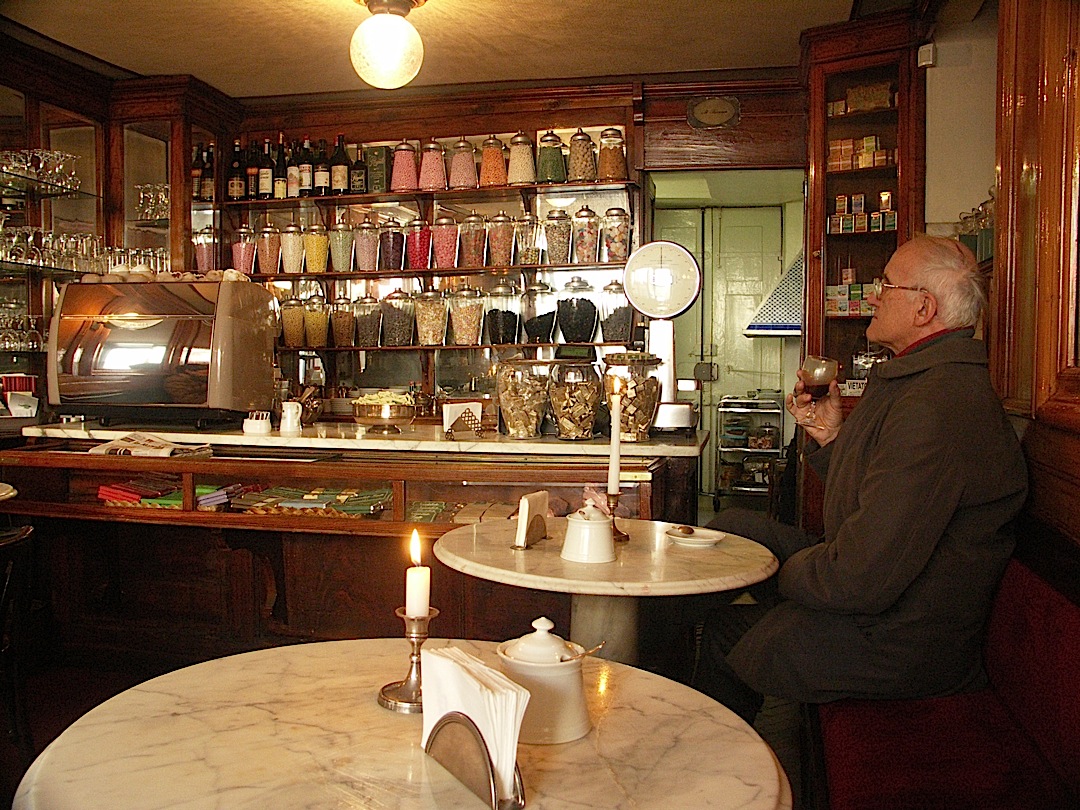 (from which it gets its name) of hot espresso, chocolate,
and
milk. Various aficionados debate
the origins of this totemic Turinese concoction, though the most widely
accepted was that it was first made at Caffè al Bicerin (above and left), which
opened on the
Piazza della Consolata in 1763. (Incidentally,
the
church
across
the
piazza
has
one
of
the
most
extraordinary
interiors
in
Turin.)
(from which it gets its name) of hot espresso, chocolate,
and
milk. Various aficionados debate
the origins of this totemic Turinese concoction, though the most widely
accepted was that it was first made at Caffè al Bicerin (above and left), which
opened on the
Piazza della Consolata in 1763. (Incidentally,
the
church
across
the
piazza
has
one
of
the
most
extraordinary
interiors
in
Turin.)
Like
the
equally
famous
though
not
nearly
so
old
Caffé
Sant’
Eustachio
in
Rome,
Caffè
al
Bicerin is
a
revered
monument
to
coffee
and
chocolate,
a
dim,
fifteen-by-twenty-five
foot
room with tiny marble tables, candles that
seem
votive, antique mirrors, dark red banquettes, wall sconces, and old
wooden
chairs. The cramped counter holds jars of bon bons and chocolates, and
the old
Faema coffee machine rumbles and roars like a FIAT assembly line when
the
glasses of thick, semi-sweet bicerins are made.
My wife and I entered feeling like acolytes,
privileged to sit at the tiny tables among an array of Torinesi, many
of them
old men and women for whom a morning bicerin is like receiving Holy
Communion,
as a restorative against the Piedmontese fog and drizzle.
This article is
expanded from the original that appeared in the magazine La Cucina Italiana.
by John Mariani
JONES
WOOD
FOUNDRY
401
East 76th Street (between First
& York Avenues)
212-249-2700
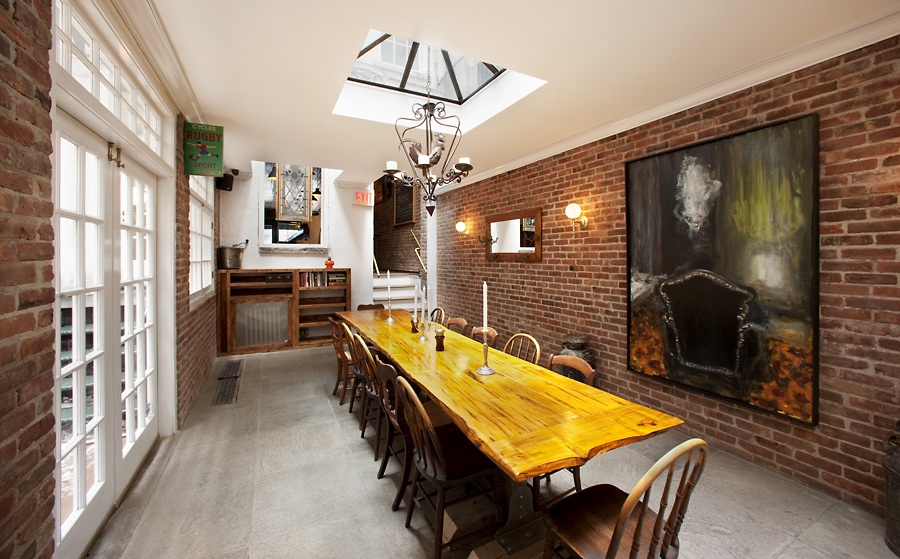 Are
you
as
tired
as
I
am
of
new
restaurants
popping
up in every American
city as "gastro-pubs"? It's not that the idea of a small bar
serving above-average food is a bad one, as evidenced by superior
examples like The Spotted Pig in NYC and Longman & Eagle in
Chicago, but, as always, those restaurateurs who simply jump on
the next faddish bandwagon have nothing new to offer, except
their huge
size, and soon roll off into the gastro-dustbin.
Are
you
as
tired
as
I
am
of
new
restaurants
popping
up in every American
city as "gastro-pubs"? It's not that the idea of a small bar
serving above-average food is a bad one, as evidenced by superior
examples like The Spotted Pig in NYC and Longman & Eagle in
Chicago, but, as always, those restaurateurs who simply jump on
the next faddish bandwagon have nothing new to offer, except
their huge
size, and soon roll off into the gastro-dustbin.
As in any good restaurant it is the chef who is
going to drive
the quality of food, not a mere conceptualizer who thinks bigger and
louder is better and that a few pub favorites like fish and chips will
give them credibility. In the case of the new Jones Wood Foundry
on the Upper East Side, the driving force is a consummate pro and, for
once, a true Brit who knows as much about haute cuisine as he does
traditional English fare. Jason Hicks first made his mark in NYC
at the very La Goulue and Orsay, where he occasionally veered away from
the rigid French bistro menus to add his own style and
sensibility. No one in NYC cooks better game in season.
So when Hicks took over as chef and partner, with
Yves Jadot, at Jones Wood Foundry, housed in an 1860s building
that once made manhole covers and later became a school in a
neighborhood once known as Jones Wood, I was curious what kind of menu
he would craft. He has the space for largess--three rooms and an
inner garden courtyard with French doors, a long bar up front, and a
communal table (above).
Exposed brickwork and antique mirrors carry through the idea of an old
pub and eatery, as does a high-backed leather
Chesterfield
banquette in the dining room.
The place is already doing banner business since opening a few weeks
ago, especially with deck shoe-loafered locals from the UES.
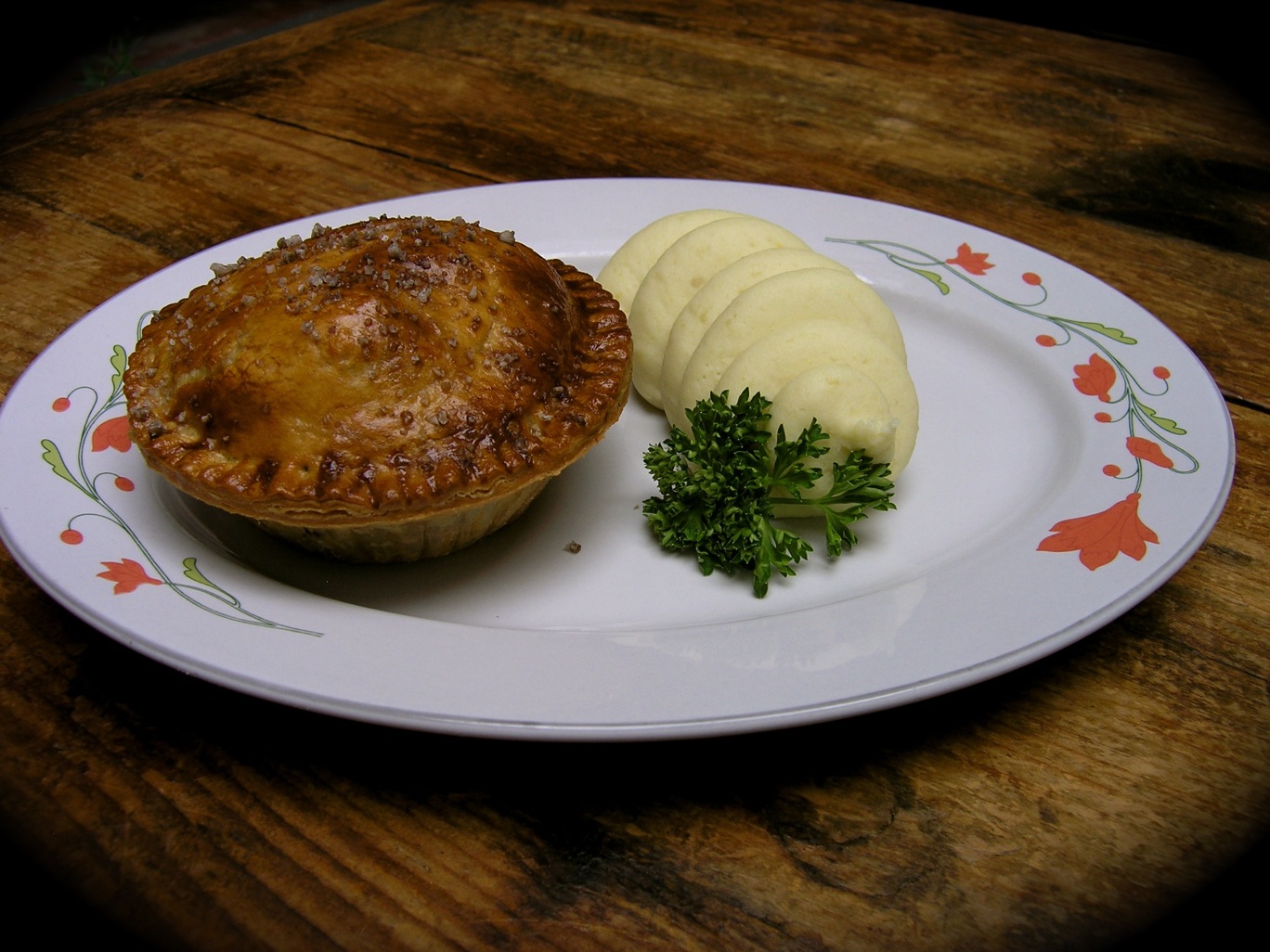 Sadly, the absurd blue laws of
NYC that prohibit a restaurant from serving booze if too close to a
school allow JWF to serve only wine and beer; the selection of the
former is a tad weak but the latter is a good and unusual selection.
Sadly, the absurd blue laws of
NYC that prohibit a restaurant from serving booze if too close to a
school allow JWF to serve only wine and beer; the selection of the
former is a tad weak but the latter is a good and unusual selection.
One of the unique things at JWF is its "toasts," a
range of scrumptious Anglo-appetizers and lunch items that include a
fine citrus potted crab with tomato powder; a silky textured, very
rich chicken liver and foie gras mousse; marinated sardines with a
chickpea spread; and--quite unusual anywhere these days--Scotch egg
with tartar
sauce. When asked about the preparation, our charming waitress
said, "Well, it's an egg crusted with bacon and deep-fried. What's not
to love?" and she was right.
At dinner the traditional dishes are all in array,
along with some seasonal ones like Hicks's beautiful cream of corn soup
with shrimp, chard and tomato, a silky, cold rendering that was perfect
for a roasting hot NYC evening. The salmon gravlax with beet
tartare and mâche was one of the best I've had west of the Irish
Sea. Hicks also offers three crusted savory pies, and the flaky
crusts are extraordinary. There's a hearty steak and kidney pie
(left), maybe a little heavy
for hot weather, and a cottage pie that was
supposed to be full of shortrib meat and mushrooms, but I fished around
for the meat
and found next to none.
The
main
courses
contain
textbook
versions
of
Anglo
cookery,
starting
off
with
impeccably
crisp,
sweet beer-battered cod (right)
with
positively addictive
"chips" (fat, fried potatoes). There is a plate of faggots and
onion gravy, which the late English food writer Jane Grigson 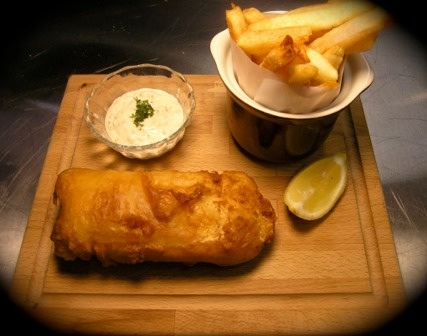 called "a
good-tempered dish" once popular to use up odd cuts and
leftovers like hearts, liver, and kidneys. An "old-fashioned
roast chicken" could use some updating. Then there's a hefty platter of
Myers of Keswick bangers and mash with caramelized onion gravy. Myers of Keswick, on Hudson
Street, is that rare NYC grocery selling British goods, and their
bangers (sausages) are delicious and go splendidly with the rich, sweet
gravy, to be sopped up with very buttery mashed potatoes. (I was,
by the way, surprised to find, while reading Keith Richards' new
autobiography, that the gnarled old guitarist's favorite dish was
bangers and mash, which he himself would often cook up and eat before
going onstage.)
called "a
good-tempered dish" once popular to use up odd cuts and
leftovers like hearts, liver, and kidneys. An "old-fashioned
roast chicken" could use some updating. Then there's a hefty platter of
Myers of Keswick bangers and mash with caramelized onion gravy. Myers of Keswick, on Hudson
Street, is that rare NYC grocery selling British goods, and their
bangers (sausages) are delicious and go splendidly with the rich, sweet
gravy, to be sopped up with very buttery mashed potatoes. (I was,
by the way, surprised to find, while reading Keith Richards' new
autobiography, that the gnarled old guitarist's favorite dish was
bangers and mash, which he himself would often cook up and eat before
going onstage.)
And so on to sticky toffee pudding with treacle
sauce, as sweet and lovable a dessert as there ever will be. But I'm
afraid I may never find a sherry trifle I like, and did not find it
here.
It would, then, be a misnomer if
not a downright insult, to lump Jones Wood Foundry with all the other
clichés of the gastropub genre downtown and in Brooklyn
these days, for
Hicks is such a superior, knowledgeable chef about this kind of food
that you will want to come here to taste the Real McCoy and do so
within a very charming, well-run establishment.
Dinner starters and soups range from $7 to $12. Main courses $17-26.
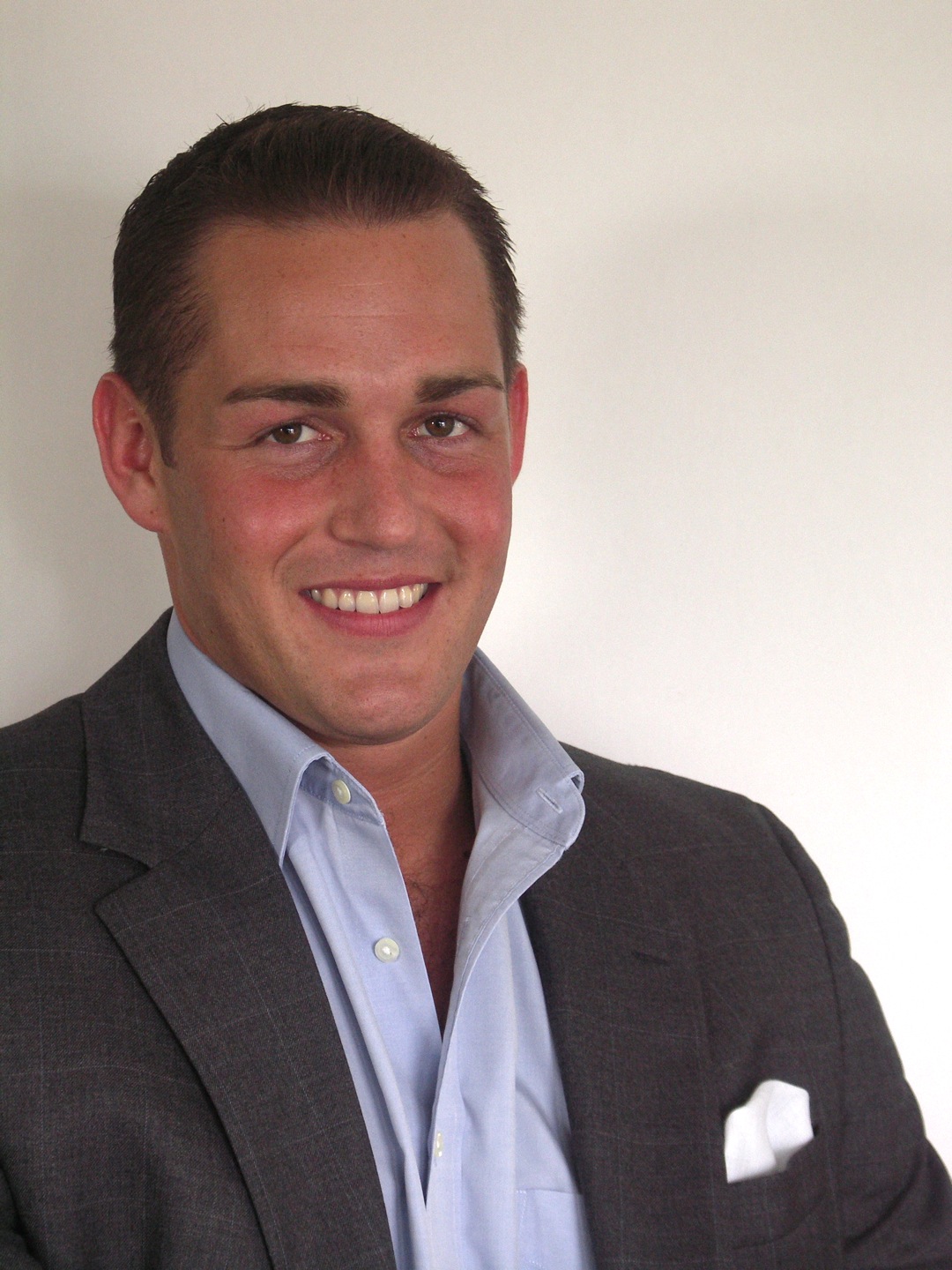
MAN ABOUT TOWN
by
Christopher Mariani
Gazala's
380
Columbus Avenue (at
78th
Street)
212-873-8880
gazalaplace.com
 Food
and
restaurants
have never been so all-consuming to New Yorkers as over
the past five years. I remember friends of mine who rarely tasted
anything beyond their mother’s cooking who are now out twice a week
ordering
exotic sushi and spending every last dollar they earn to be one of the
first to
try out the city’s hottest new restaurants. The food craze has hit NYC
hard, so
that cuisines that were once almost impossible to find are popping up
around
every corner like Starbucks. (Indeed, there's a newly coined word for
restaurants that are intended to come and go--pop-ups.) Were you to ask
the
average
New Yorker where is a good place to grab some Thai or Indian food, you
better
have a pen and a long sheet of paper handy.
Food
and
restaurants
have never been so all-consuming to New Yorkers as over
the past five years. I remember friends of mine who rarely tasted
anything beyond their mother’s cooking who are now out twice a week
ordering
exotic sushi and spending every last dollar they earn to be one of the
first to
try out the city’s hottest new restaurants. The food craze has hit NYC
hard, so
that cuisines that were once almost impossible to find are popping up
around
every corner like Starbucks. (Indeed, there's a newly coined word for
restaurants that are intended to come and go--pop-ups.) Were you to ask
the
average
New Yorker where is a good place to grab some Thai or Indian food, you
better
have a pen and a long sheet of paper handy.
In
2007,
chef
Gazala
Halabi,
who
was
born
and
raised
in Daliat el-Carmel,
Israel, opened her first restaurant in Hell’s Kitchen named Gazala
Place. She
was serving Druze cuisine, a fare that shares the essence of many
Eastern Mediterranean dishes
from Lebanon, Jordan and Israel. NYC residents embraced Halabi’s
cooking at
Gazala Place, and just three years later she opened her second
location, Gazala’s,
on the Upper West Side where I dined last week. According
to Halabi, hers are the only two restaurants serving this kind of
cuisine.
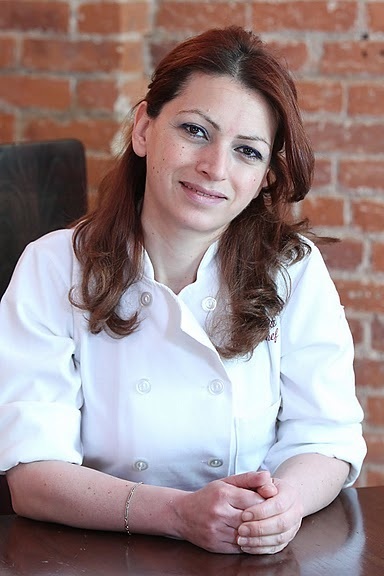 The
restaurant
is
in
the
process
of
receiving
its
liquor
license and claim
they
will have it soon, but call ahead and make sure before you show up
empty
handed. The night I dined it was still BYOB, so I brought a nice bottle
of red wine.
The
restaurant
is
in
the
process
of
receiving
its
liquor
license and claim
they
will have it soon, but call ahead and make sure before you show up
empty
handed. The night I dined it was still BYOB, so I brought a nice bottle
of red wine.
The interior is unfussy, surrounded by brick walls with arched windows, dark-wood chairs and tables, and that is all. On the right side of the dining room you can look inside the small kitchen as Halabi and cast stir up small appetizers and tasty lamb dishes. If the heat of the summer is not too intense, try and grab one of the four outside tables; they are among the best seats in the house.
After
being
greeted
by
our
amiable
waitress,
we
started
with
a selection of
cold and hot appetizers. Ground, tender meat came packed with thick
rice and
rolled up inside delicate green grape leaves, served with a side of
room
temperature cucumber yogurt; they come six to an order, none of which
were left
behind. The chickpea hummus was silky and resembled the texture of a
yogurt,
blended with a hint of tahini and a noticeable amount of lemon juice
that added
a wonderful citrus element to the usually subtle and soft dish. The
warm pitas used
to lap up just about everything in front of us were very thin and had a
pleasant chewy consistency that was not your typical pita. There is
also a delicious
babaganoush appetizer and a dish called “meat cigars,” fried pita
stuffed with
onions, meat and tahini, the one and only boring dish we were served
all
evening.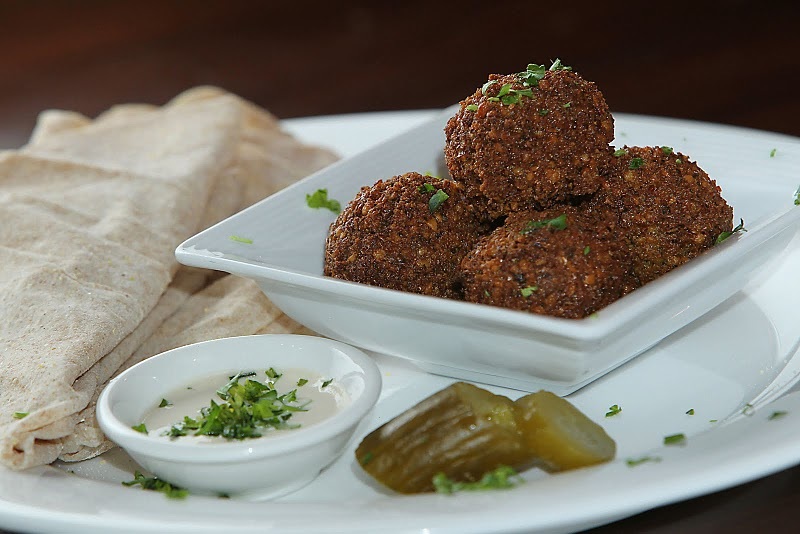
For main courses, we were very pleased with the halabi, chopped oval-shapped meat patties placed over a plate of fresh tomato sauce seasoned with parsley, onion and pine nuts. Ground meat was flattened thin and covered with cheese in the kafta tahini, a very lush dish packed with flavor.
The dessert menu is small, and I highly recommend the kenafi, which is made to order, filled with sweet cheese, pistachio and syrupy honey that gets absorbed into the crispy shredded dough, easily enough for two people. If you have room also try the traditional baklava, a flaky pastry filled with pistachio nuts and a honey-lemon mixture.
From start to finish Gazala stays true to its Druze culture and doesn’t offer anything outside of the cuisine, except for a diner-sized order of blueberry cake. The wait staff is warm and although could use a bit of refinement, they still leave you walking out with a gracious smile and tamed appetite.
To contact Christopher Mariani send an email to christopher@johnmariani.com
You can follow the Man About Town on Twitter @VirtualGourmet
American
Sauvignon Blancs’ Styles Tough to Pin Down
By
John Mariani
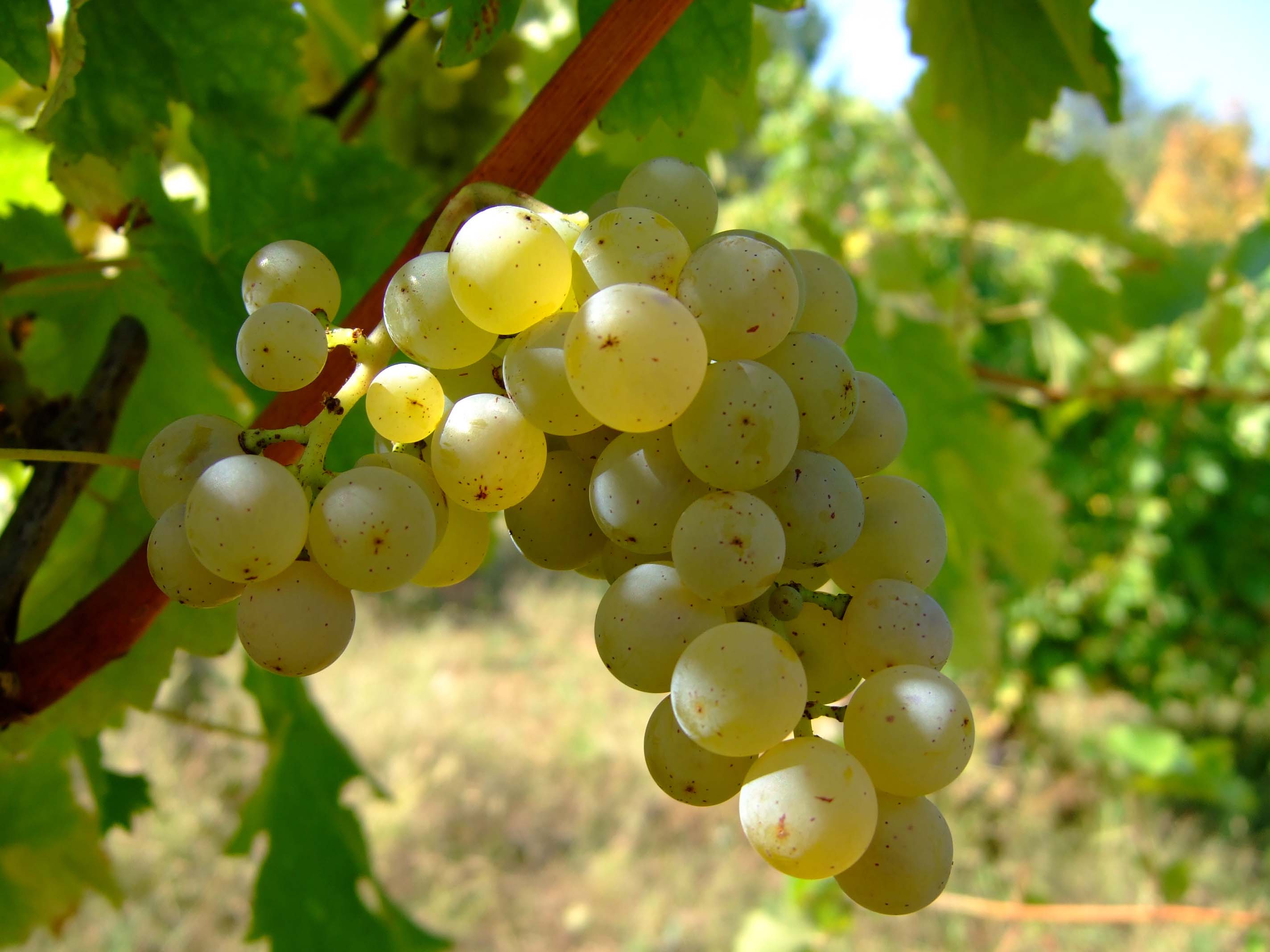 More often than
not
when ordering a white wine I go for a Sancerre or Pouilly-Fumé,
made from the
sauvignon blanc grape in France’s Loire Valley. I find it as versatile
as an
aperitif as I do with a wide variety of foods to come, and the price is
usually
right.
More often than
not
when ordering a white wine I go for a Sancerre or Pouilly-Fumé,
made from the
sauvignon blanc grape in France’s Loire Valley. I find it as versatile
as an
aperitif as I do with a wide variety of foods to come, and the price is
usually
right.
What I almost never do is order a sauvignon blanc from America, where it is sometimes called fumé blanc. All the virtues I find in French sauvignon blancs—-their aromatic bouquet, herbaceous, slightly grassy flavor, and lightness of structure—seem so often squandered in California and Pacific Northwest wineries, which tend to overemphasize herbal notes, making most taste like a newly mown lawn with plenty of dandelions and a little fertilizer thrown in.
Many examples deliberately imitate the fruit punch flavors of the enormously successful Cloudy Bay and other sauvignon blancs out of New Zealand. One wine writer writing about Cloudy Bay found “Tangerine, mango and citrus flavors are pure and focused, smooth, round and wonderfully refreshing, with peach, Key lime pie, mineral and floral elements that really take off on the finish.” As I said, fruit punch.
America’s sauvignon blancs tend not to be quite that aggressive, but their styles differ radically. Some very light, others hefty, with up to 14.5 percent alcohol. The big grassy ones are a mouthful but their charms fade very fast after a few sips. The varietal’s prodigious growth and vigor can lead to an under ripeness that can add to those herby demerits. The varietal had a surge in popularity after the late Robert Mondavi re-named it fumé blanc in 1966, to avoid confusion with cabernet sauvignon and giving it a sexy French nuance.
Many California wineries don’t allow much if any skin contact with the grape juice; others do. Some age only in stainless steel; others use oak barrels. In some instances, semillon or other grapes may be added.
It’s difficult, then, to pin down the American sauvignon blanc style. But with summer and outdoor grilling upon us, a reasonable case can be made for the American varietal as a good choice for big smoky flavored foods. With that in mind, I collected a slew of western state sauvignon blancs of different styles and vintages and tasted them with and without such foods.
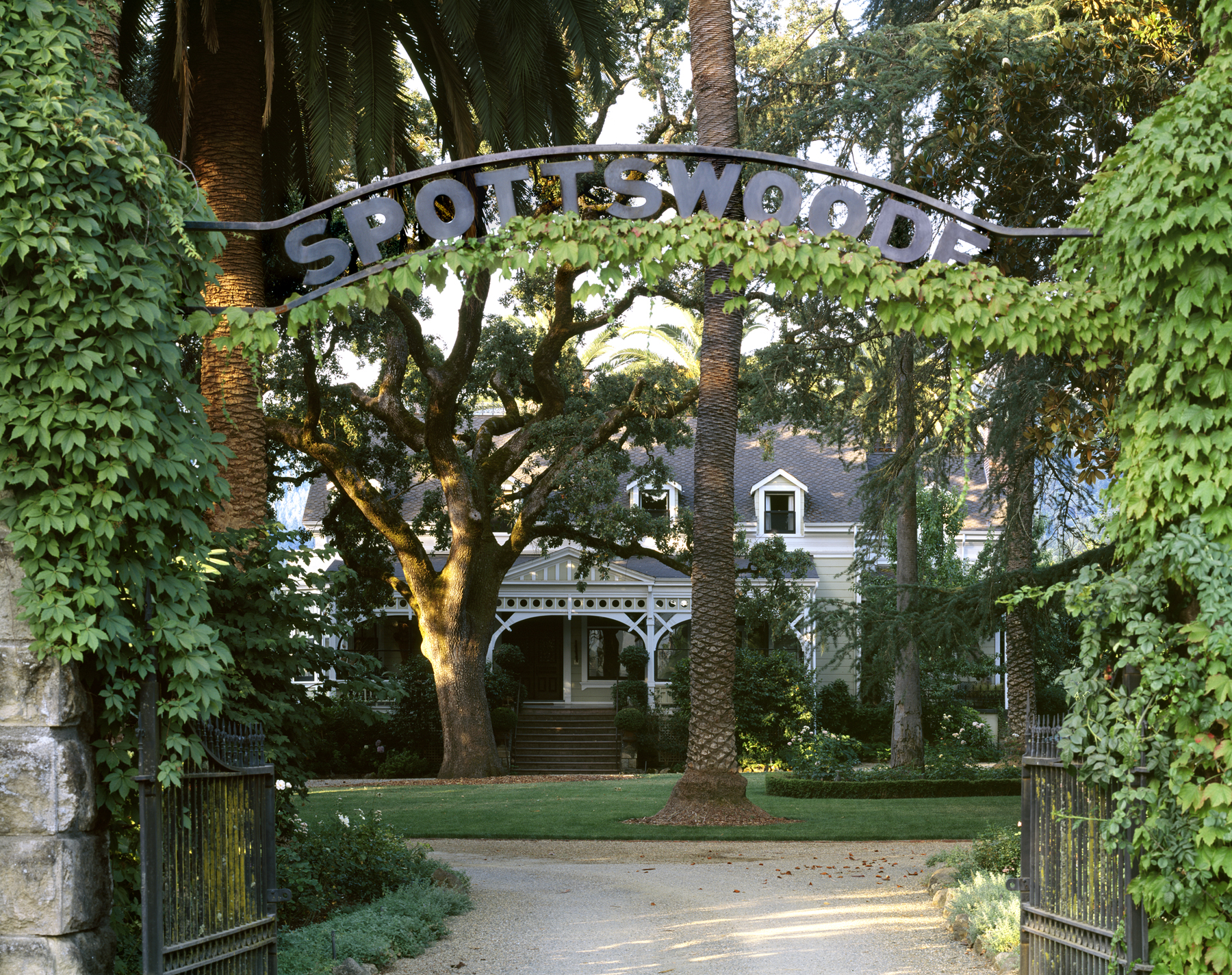 Sineann 2007 ($30)—This
small Yamhill County, Oregon, producer, best known for its pinot noirs.
Unfortunately, although the bottle I sampled had a very tight glass
closure,
the smell was slightly chemical and the wine itself, obvious from its
color,
starting to oxidize.
Sineann 2007 ($30)—This
small Yamhill County, Oregon, producer, best known for its pinot noirs.
Unfortunately, although the bottle I sampled had a very tight glass
closure,
the smell was slightly chemical and the wine itself, obvious from its
color,
starting to oxidize.
Carica Kick Ranch 2007 ($25)—Sonoma Valley’s Carica has only been making wine since 2005 but already has a considerable following. The owners insist their sauvignon blancs follow “classic French style” with “crisp acidity,” with 25 percent sauvignon musque is added and 10 percent of the first blend ages in new French oak. This was indeed a very Sancerre-like sauvignon blanc, tasted, with a lovely fresh bouquet, excellent body and clean acids. This was clearly the best of my tasting, perfect will fish cooked on the grill.
Windsor Sonoma 2007 ($15)—With vineyards in the warm Russian River Valley, Windsor Sonoma takes advantage of cool summer nights to keep acidity levels high, with a judicious 13.9 percent alcohol. The color is very, very pale, the aroma herbaceous, but the overall taste flabby, without those promised acids evident. It’s a one-dimensional wine.
Groth Vineyards & Winery 2007
($26)—Located
in Napa’s Oakville appellation, Groth has been highly regarded for its
sauvignon blancs since the 1980s, made from grapes grown in
microclimates that
Goth’s website says gives the wine “a lush, full melon/citrus character
in the
aroma and in the flavor.” Leaving the juice on the skins gives it more
body,
but you get a high alcohol level of 14.5 percent. It’s
big,
it’s
floral,
it’s
pleasantly
grassy
but
not
overdone. This is a very fine example
of the bold California style of ripe fruit and balance of acidity, as
well as a singular family effort, as shown at right, with Dennis,
Andrea and Suzanne Groth anointing the harvest. 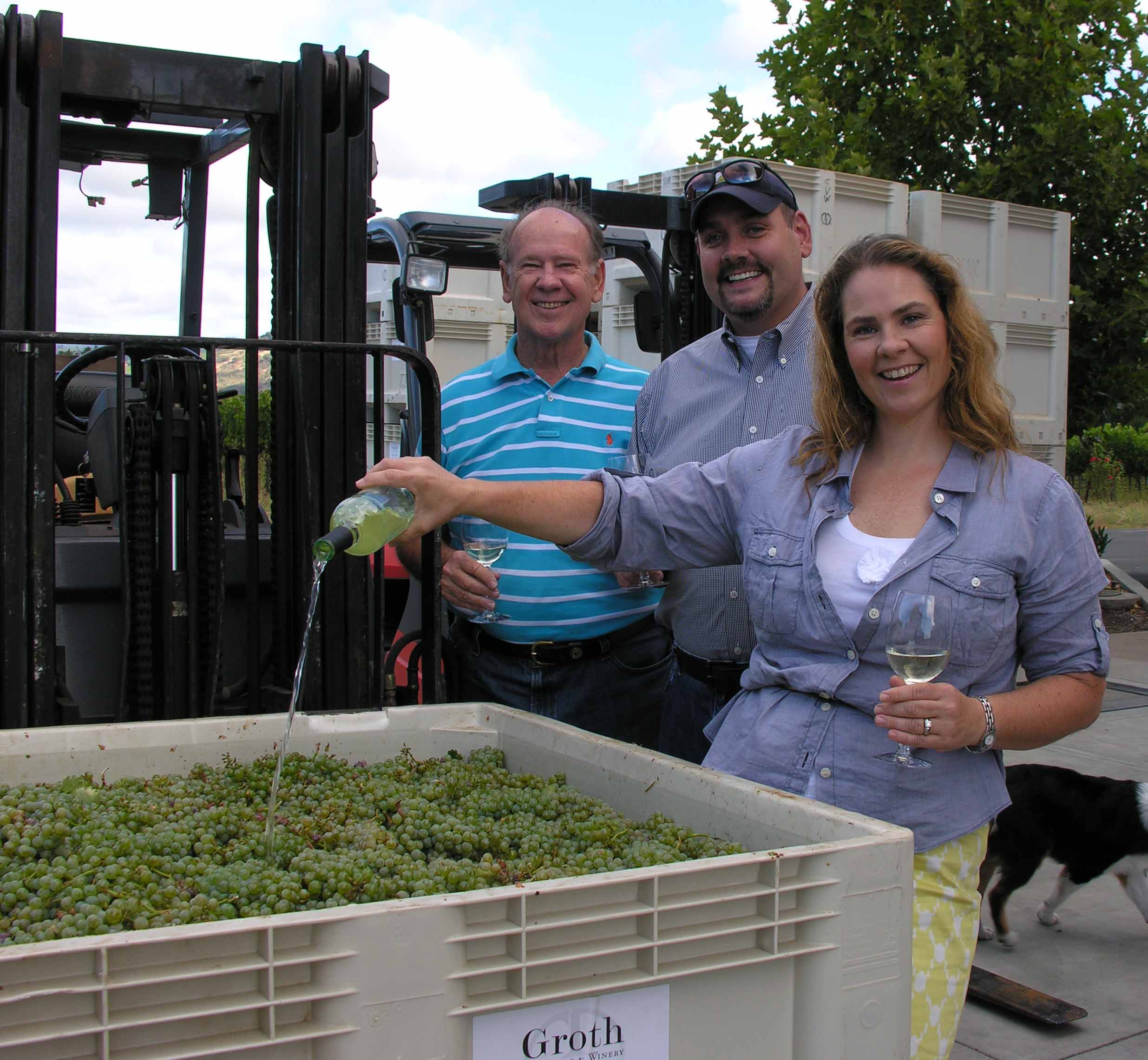
Turnbull 2008 ($23)—Napa-based Turnbull makes a wide range of wines, sourcing grapes from four Oakville and Calistoga vineyards, and the juice spends an unusually long time on the lees. Very pale in color, with a modest apple-like nose, it begins brightly on the palate but fades fast without any real finish. It would be fine with grilled chicken or even hot dogs.
Spottswoode Estate Vineyard & Winery 2009 ($35-$40)—Napa’s Spottswoode specializes two cabernets and its sauvignon blanc, fermenting them in small stainless barrels, then French oak to add toast and spice. This is another fine example in the Loire Valley style, a very creamy wine but with tantalizing acid and freshness that would make an excellent aperitif or a wine to go with summer salads and tomatoes with goat’s cheese.
John Mariani's wine column appears in Bloomberg Muse News, from which this story was adapted. Bloomberg News covers Culture from art, books, and theater to wine, travel, and food on a daily basis.
❖❖❖
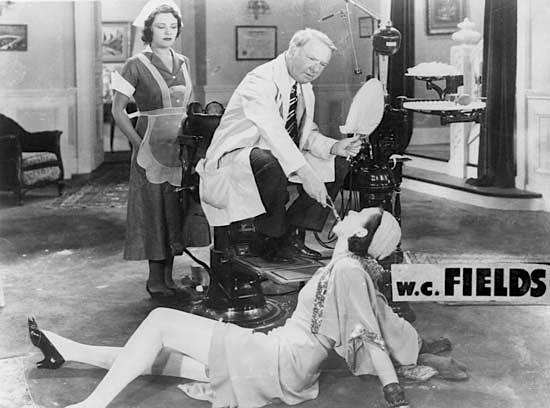
BUT THEY HAD TO STOP DRINKING WHILE DR. HERZOG WAS DRILLING
Texas dentist Dr. Clint Herzog, tired of
people saying they hated going to the dentist, began offering beer,
wine and TV shows to his patients "to take the edge off" a
visit.
UH,
MAYBE WE’LL JUST TAKE THE CHECK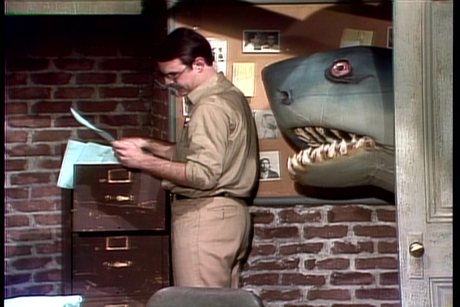
“On a warm spring night, one waitress . . . made an unusual, Bloomfield-worthy offer. `We have one fish head left. It’s snapper.’ Met with stares less skeptical than dumbfounded, she pressed on: `You can eat the cheek, the neck—I had the eyeballs, they were good. You can eat the brain—it’s involved. Some people like it.” –Shauna Lyan, “The John Dory Oyster Bar,” The New Yorker (5/30/11).
Any of John Mariani's books below
may be ordered from amazon.com.
" A fact-filled,
entertaining history [that] substantiates its title with hundreds of
facts in this meaty history of the rise of Italian food culture around
the
globe. From Charles Dickens's journey through Italy in 1844 to
20th-century
immigrants to America selling ice cream on the streets of New Orleans,
Mariani
constantly surprises the reader with little-known culinary anecdotes
about
Italy and its people, who have made pasta and pizza household dishes in
the
U.S. and beyond."--Publishers Weekly "Equal
parts
history,
sociology,
gastronomy,
and
just
plain
fun,
How
Italian
Food
Conquered
the
World
tells
the
captivating
and
delicious
story
of
the
(let's
face
it)
everybody's
favorite
cuisine
with
clarity,
verve
"A
fantastic and fascinating read, covering everything from the influence
of Venice's spice trade to the impact of Italian immigrants in
America and the evolution of alta cucina. This book will serve as a
terrific resource to anyone interested in the real story of Italian
food."--Mary Ann Esposito, host of PBS-TV's Ciao Italia. "John
Mariani
has
written
the
definitive
history
of
how
Italians
won
their
way
into
our
hearts,
minds,
and
stomachs.
It's
a
story
of
pleasure
over
pomp
and
taste
over
technique."--Danny
Meyer,
owner
of
NYC
restaurants
Union
Square
Cafe,
Gotham
Bar
&
Grill,
The
Modern,
and
Maialino.
|
 |
 |
 |
 |
 |
 |
 |
 |
❖❖❖
 Everett
Potter's
Travel
Report:
Everett
Potter's
Travel
Report: 
 Eating
Las
Vegas is the new on-line site for Virtual Gourmet
contributor John
A. Curtas., who since 1995 has been commenting on the Las Vegas food
scene and reviewing restaurants for Nevada Public Radio. He is
also
the restaurant critic for KLAS TV, Channel 8 in Las Vegas, and his past
reviews can be accessed at KNPR.org.
Click
on
the
logo
below
to
go
directly
to
his
site.
Eating
Las
Vegas is the new on-line site for Virtual Gourmet
contributor John
A. Curtas., who since 1995 has been commenting on the Las Vegas food
scene and reviewing restaurants for Nevada Public Radio. He is
also
the restaurant critic for KLAS TV, Channel 8 in Las Vegas, and his past
reviews can be accessed at KNPR.org.
Click
on
the
logo
below
to
go
directly
to
his
site.

Tennis Resorts Online: A Critical Guide to the World's Best Tennis Resorts and Tennis Camps, published by ROGER COX, who has spent more than two decades writing about tennis travel, including a 17-year stretch for Tennis magazine. He has also written for Arthur Frommer's Budget Travel, New York Magazine, Travel & Leisure, Esquire, Money, USTA Magazine, Men's Journal, and The Robb Report. He has authored two books-The World's Best Tennis Vacations (Stephen Greene Press/Viking Penguin, 1990) and The Best Places to Stay in the Rockies (Houghton Mifflin, 1992 & 1994), and the Melbourne (Australia) chapter to the Wall Street Journal Business Guide to Cities of the Pacific Rim (Fodor's Travel Guides, 1991).

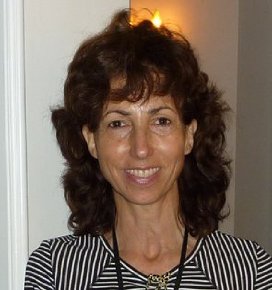
The Family Travel Forum
- A community for those who
"Have Kids, Still Travel" and want to make family vacations more fun,
less work and better value. FTF's travel and parenting features,
including
reviews of tropical and ski resorts, reunion destinations, attractions,
holiday
weekends, family festivals, cruises, and all kinds of vacation ideas
should be
the first port of call for family vacation planners. http://www.familytravelforum.com/index.html
ALL YOU NEED BEFORE YOU GO


MARIANI'S VIRTUAL GOURMET NEWSLETTER is published weekly. Editor/Publisher: John Mariani.
Contributing Writers: Christopher
Mariani, Robert Mariani,
John A. Curtas, Edward Brivio, Mort
Hochstein, Suzanne Wright, and
Brian Freedman. Contributing
Photographers: Galina Stepanoff-Dargery, Bobby Pirillo. Technical
Advisor:
Gerry McLoughlin.
© copyright John Mariani 2011
